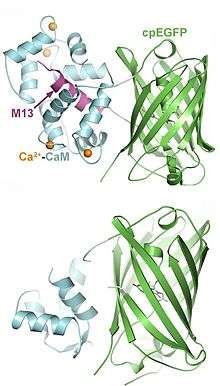GCaMP

GCaMP is a genetically encoded calcium indicator, or GECI initially developed by Junichi Nakai.[1] GCaMP is created from a fusion of green fluorescent protein (GFP), calmodulin, and M13, a peptide sequence from myosin light chain kinase. The advantage of GECI's is that they can be genetically specified for studies in living organisms. The first transgenic mouse expressing a GCaMP was reported in 2004 [2] and GCaMP was subsequently improved to GCaMP2, which was stable at mammalian body temperatures and enabled the first in vivo mammalian recordings using a GECI.[3] GCaMPs have been subsequently modified to progressively improve the range of the fluorescence signal, resulting in GCaMP3[4] through GCaMP8.[5] Additionally, red fluorescence GECIs have been developed that expand the spectral options for multi-lineage imaging[6]
GFP is circularly permutated so that the N- and C-termini are fused, creating a new terminus in the middle of the protein. Fused to the new terminus is calmodulin (CaM) and the M13 domain of a myosin light chain kinase. Calmodulin is a symmetrical, hinge-like protein that binds to four calcium ions via E-F motifs. When calcium is present, CaM undergoes a conformational change, and the hinge region is able to bind helical peptide chains on target proteins, such as M13. In the absence of calcium, the circularly permutated fluorescent proteins exist in a poorly fluorescent state due to a water pathway that enable protonation of the chromophore and poor absorbance at the excitation wavelengths. Ca2+ binding to the calmodulin moiety results in a structural shift that eliminates this solvent pathway, rapid de-protonation of the chromophore, and bright fluorescence.[7][8]
See also
References
- ↑ Nakai J., Ohkura M., Imoto K. (2001). "A high signal-to-noise Ca(2+) probe composed of a single fluorescent protein". Nature Biotechnology. 19: 137–141. PMID 11175727. doi:10.1038/84397.
- ↑ Ji G; et al. (2004). "Ca2+ sensing transgenic mice: postsynaptic signaling in smooth muscle". J. Biol. Chem. 279: 21461–21468. PMID 14990564. doi:10.1074/jbc.m401084200.
- ↑ Tallini Y.P.; et al. (2006). "Imaging cellular signals in the heart in vivo: Cardiac expression of the high-signal Ca2+ indicator GCaMP2". PNAS. 103: 4753–4758. doi:10.1073/pnas.0509378103.
- ↑ Tian L.; et al. (2009). "Imaging neural activity in worms, flies and mice with improved GCaMP calcium indicators". Nat. Methods. 6: 875–881. doi:10.1038/nmeth.1398.
- ↑ Ohkura, M. et. al. (2012). "Genetically encoded green fluorescent Ca2+ indicators with improved detectability for neuronal Ca2+ signals". PLoS ONE. 7 (12): 051286. PMC 3519846
 . PMID 23240011. doi:10.1371/journal.pone.0051286.
. PMID 23240011. doi:10.1371/journal.pone.0051286. - ↑ Zhao, Y. et. al. "An expanded palette of genetically encoded Ca²⁺ indicators" Science 333:1888-1891, 2011.
- ↑ Wang Q.; et al. (2008). "Structural basis for calcium sensing by GCaMP2". Structure. 16: 1817–1827. doi:10.1016/j.str.2008.10.008.
- ↑ Akerboom J.; et al. (2009). "Crystal structures of the GCaMP calcium sensor reveal the mechanism of fluorescence signal change and aid rational design". J. Biol. Chem. 284: 6455–6464. PMC 2649101
 . PMID 19098007. doi:10.1074/jbc.m807657200.
. PMID 19098007. doi:10.1074/jbc.m807657200.